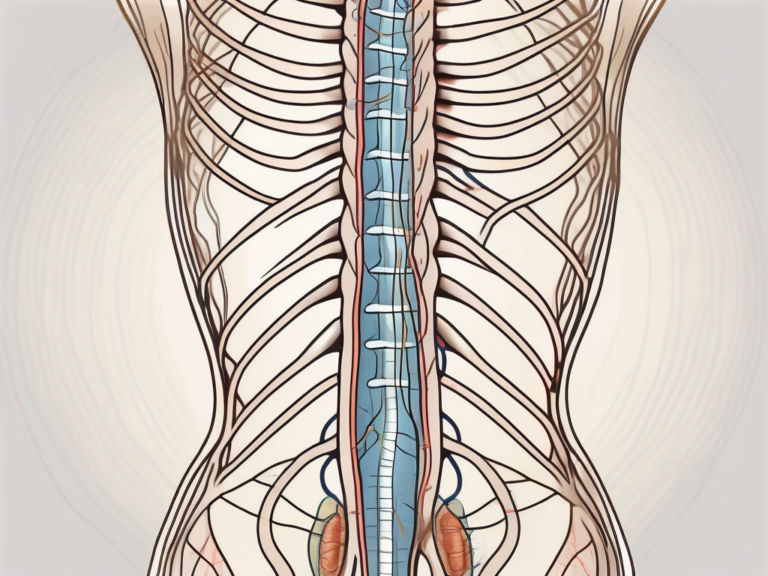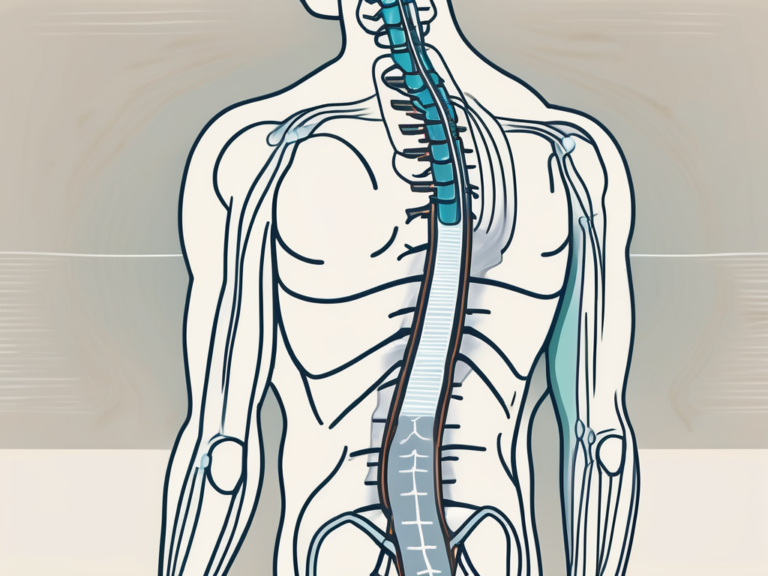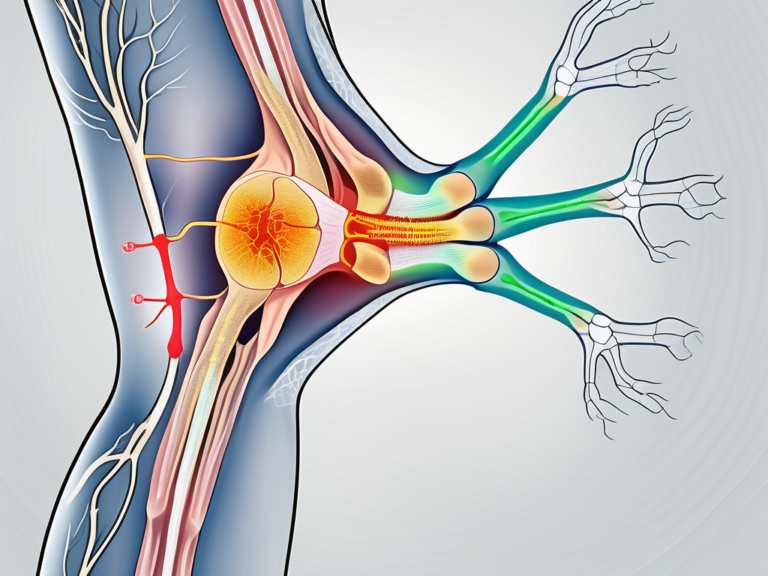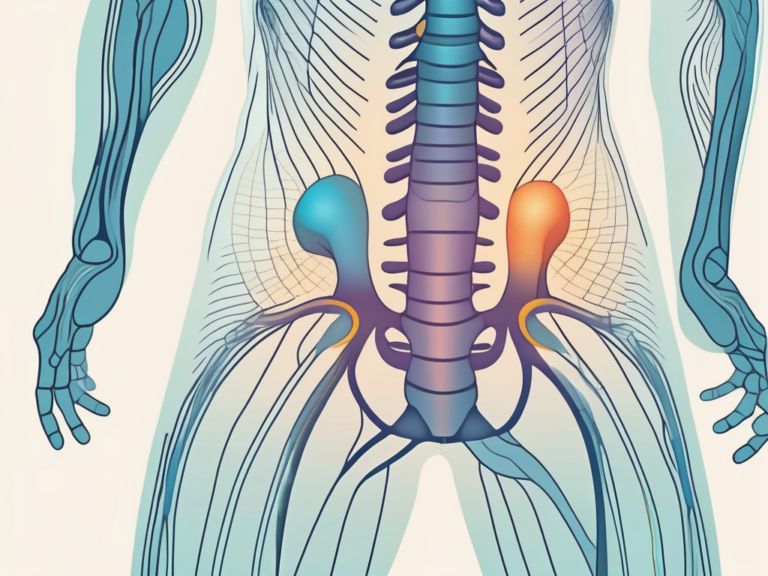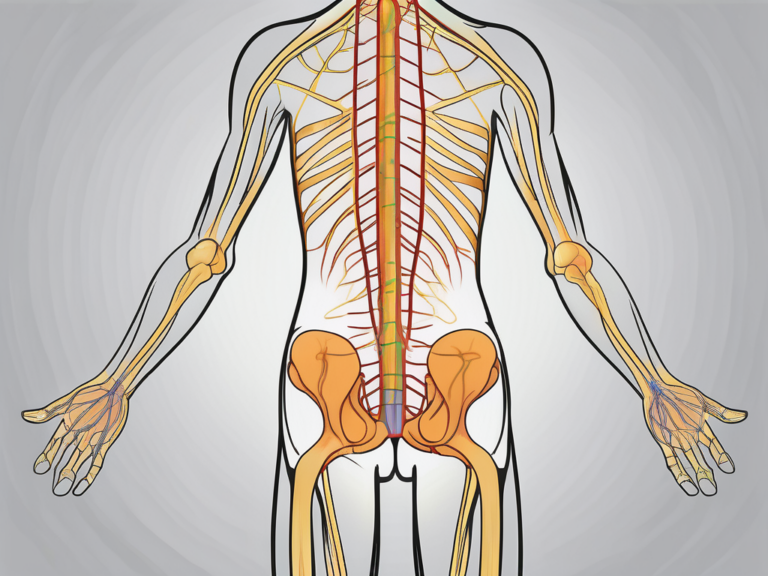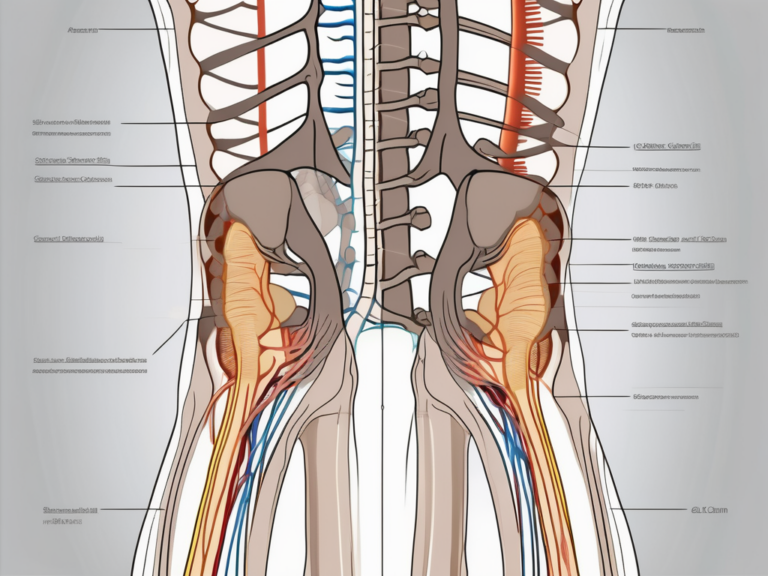Understanding the Origins of the Sciatic Nerve: Lumbar and Sacral Nerves Explained
The sciatic nerve is the longest and thickest nerve in the human body. It plays a crucial role in our ability to move and feel sensations in the lower extremities. To fully understand the complexity of the sciatic nerve, it is important to examine the origins of this vital nerve and its connection to the lumbar and sacral nerves.
The Anatomy of the Sciatic Nerve
The sciatic nerve, one of the largest nerves in the human body, originates from the lower part of the spinal cord. Specifically, it arises from the lumbar and sacral regions, which are located in the lower back and pelvis. The sciatic nerve is formed by the fusion of nerve roots from the fourth lumbar vertebra to the third sacral vertebra. These nerve roots, like tiny branches, come together to create a bundle of nerves that form the sciatic nerve.
As the sciatic nerve emerges from the spinal cord, it begins its journey down the back of the leg. It travels through the buttock region, passing underneath the piriformis muscle, which is an important muscle involved in hip rotation. From there, the sciatic nerve continues its course, branching out into smaller nerves that innervate various muscles and provide sensory information to the lower extremities.
The Role of the Sciatic Nerve in the Body
The sciatic nerve plays a crucial role in our ability to move and perceive sensations in the lower body. It serves as the main communication pathway between the spinal cord and the lower extremities. By transmitting both sensory and motor signals, the sciatic nerve enables us to perform everyday movements such as walking, running, and jumping.
Motor signals carried by the sciatic nerve control the muscles in the thighs, legs, and feet. These signals allow us to contract and relax the muscles, coordinating our movements and maintaining balance. Without the sciatic nerve, our lower extremities would be rendered immobile, making even the simplest tasks a challenge.
In addition to motor function, the sciatic nerve also carries sensory information from the lower extremities back to the brain. This allows us to perceive sensations like touch, temperature, and pain. When we step on a sharp object or touch a hot surface, it is the sciatic nerve that relays these signals to the brain, prompting us to react and protect ourselves.
The Connection Between the Sciatic Nerve and the Spinal Cord
The sciatic nerve and the spinal cord are closely intertwined, forming a vital connection between the brain and the rest of the body. The spinal cord, a long, cylindrical structure, serves as the main pathway for nerve signals to travel between the brain and the peripheral nervous system.
The nerve roots that make up the sciatic nerve originate in the lumbar and sacral regions of the spinal cord. These nerve roots exit the spinal cord through small openings called intervertebral foramina. As they emerge, they come together to form the sciatic nerve, which extends down the back of the leg.
Along its journey, the sciatic nerve interacts with various structures, including muscles, blood vessels, and other nerves. It is important for the sciatic nerve to maintain its integrity and avoid compression or injury, as any disruption can lead to pain, weakness, or numbness in the lower extremities.
In conclusion, the sciatic nerve is a complex and essential component of the human body. Its role in transmitting signals between the spinal cord and the lower extremities allows us to perform everyday movements and perceive sensations. Understanding the anatomy and function of the sciatic nerve helps us appreciate the intricate network of nerves that enable us to navigate the world around us.
Lumbar Nerves: A Closer Look
The lumbar nerves are a group of nerve roots that emerge from the lumbar region of the spinal cord. These nerves play a crucial role in the functioning of the lower back and lower extremities.
The lumbar nerves, also known as the lumbar plexus, are a complex network of nerves that originate from the spinal cord in the lower back. They consist of five pairs of nerves, labeled L1 to L5, which branch out and innervate various structures in the lower body.
One of the key functions of the lumbar nerves is to control the movement and sensation of the lower back, buttocks, thighs, and parts of the legs. These nerves innervate the muscles responsible for flexing and extending the spine, allowing us to bend forward and backward. They also play a crucial role in hip movement, enabling us to walk, run, and perform various physical activities.
In addition to motor control, the lumbar nerves are responsible for transmitting sensory information from the lower back and legs back to the brain. This includes sensations such as touch, temperature, and pain. Without the lumbar nerves, our ability to perceive and respond to stimuli in the lower body would be greatly compromised.
The Relationship Between Lumbar Nerves and the Sciatic Nerve
The lumbar nerves contribute to the formation of the sciatic nerve, which is the longest and thickest nerve in the human body. The sciatic nerve is formed by the fusion of the nerve roots from the fourth lumbar vertebra to the third sacral vertebra.
The sciatic nerve plays a vital role in the functioning of the lower body. It provides motor control and sensation to the muscles of the thighs, calves, and feet. It is responsible for the movement of the lower limbs, allowing us to walk, kick, and perform various physical activities.
Without the proper functioning of the lumbar nerves, the health and functionality of the sciatic nerve may be compromised. Any dysfunction or disorder in the lumbar nerves can lead to conditions such as sciatica, which is characterized by pain, numbness, and weakness in the lower back, buttocks, and legs.
It is important to maintain the health of the lumbar nerves through regular exercise, proper posture, and avoiding activities that put excessive strain on the lower back. By taking care of our lumbar nerves, we can ensure the smooth functioning of the lower back and lower extremities, allowing us to lead an active and pain-free life.
Understanding Sacral Nerves
The sacral nerves are a group of nerve roots that emerge from the sacral region of the spinal cord. They play a vital role in the functioning of the pelvis and lower extremities.
The sacral nerves, also known as the sacral plexus, are an intricate network of nerves that originate from the spinal cord’s sacral region. These nerves are responsible for transmitting signals between the brain and various parts of the body, enabling essential functions such as movement, sensation, and control of bodily functions.
One of the primary functions of the sacral nerves is to control the movement and sensation of the pelvis, buttocks, genitals, and parts of the legs. They innervate the muscles involved in walking, maintaining balance, and controlling bowel and bladder function. Without the sacral nerves, these vital functions would be compromised, leading to significant difficulties in daily life.
The Importance of Sacral Nerves in the Nervous System
The sacral nerves are an integral part of the nervous system, contributing to its overall functionality. They work in conjunction with other nerves and structures to ensure the smooth transmission of signals throughout the body.
These nerves not only carry motor signals from the brain to the muscles but also transmit sensory information from the pelvis and lower extremities back to the brain. This bidirectional communication allows the brain to receive feedback about the body’s position, movement, and any potential threats or abnormalities.
Furthermore, the sacral nerves play a crucial role in maintaining proper bowel and bladder function. They enable the brain to control and coordinate the muscles responsible for these essential bodily processes. Dysfunction or damage to the sacral nerves can lead to problems such as urinary or fecal incontinence, impacting an individual’s quality of life.
How Sacral Nerves Contribute to the Sciatic Nerve
The sacral nerves merge with the lumbar nerves to form the sciatic nerve, the longest and thickest nerve in the human body. This merging occurs in the lower back region, and the resulting sciatic nerve extends down the back of each leg.
The sacral nerves provide crucial motor and sensory inputs that are essential for the proper functioning of the sciatic nerve. Motor signals from the sacral nerves enable the muscles in the legs to move and perform various actions, such as walking, running, and jumping. Sensory signals from the sacral nerves allow the brain to receive information about touch, temperature, and pain sensations in the lower extremities.
Any dysfunction or disorder in the sacral nerves may impact the overall health and functionality of the sciatic nerve. Conditions such as sacral nerve compression or injury can lead to sciatica, a painful condition characterized by radiating pain, numbness, or weakness in the lower back, buttocks, and legs.
Understanding the intricate relationship between the sacral nerves and the sciatic nerve highlights the importance of maintaining the health and well-being of these vital nerve structures. Proper care, regular exercise, and seeking medical attention for any symptoms or concerns are essential for ensuring optimal nerve function and overall neurological health.
The Formation of the Sciatic Nerve
The sciatic nerve is formed by the combination of nerve roots from the lumbar and sacral regions of the spinal cord. This intricate process is vital for the proper functioning of the lower extremities, allowing for the transmission of signals to and from the legs.
During fetal development, the nerve roots from the lumbar and sacral regions grow and extend towards the lower extremities. As they grow, they gradually form the sciatic nerve, which becomes the main nerve responsible for transmitting signals to and from the lower extremities. This process is crucial for the proper development of the sciatic nerve and its connection to the spinal cord.
The lumbar and sacral nerves play a significant role in the formation of the sciatic nerve. Their merger forms the sciatic nerve, which becomes the key pathway for nerve signals to travel between the lower extremities and the spinal cord. These nerves work together in a coordinated manner to ensure the proper development and functionality of the sciatic nerve.
Any disruption or abnormality in the development of the lumbar and sacral nerves may affect the formation and functionality of the sciatic nerve. It is essential for these nerves to grow and merge correctly to ensure the proper transmission of signals and the overall health of the sciatic nerve.
The sciatic nerve is not only responsible for transmitting signals, but it also plays a crucial role in motor function. It controls the movement of the muscles in the lower extremities, allowing for activities such as walking, running, and jumping. Additionally, the sciatic nerve is involved in sensory functions, providing feedback on touch, temperature, and pain sensations from the legs.
Throughout life, the sciatic nerve continues to play a vital role in maintaining the functionality of the lower extremities. It is susceptible to various conditions and injuries, such as sciatica, which can cause pain, numbness, and weakness in the legs. Proper care and attention should be given to the health of the sciatic nerve to ensure optimal functioning and overall well-being.
Common Disorders Related to the Sciatic Nerve
Disorders affecting the sciatic nerve can cause significant pain and discomfort, often radiating from the lower back down to the legs. It is crucial to recognize the symptoms and seek appropriate medical attention when experiencing potential sciatic nerve-related problems.
The sciatic nerve is the longest and thickest nerve in the human body, running from the lower back through the buttocks and down the back of each leg. It plays a vital role in transmitting sensory and motor signals between the legs and the brain. However, various disorders can disrupt the normal functioning of this nerve, leading to debilitating symptoms.
Identifying Symptoms of Sciatic Nerve Disorders
Symptoms of sciatic nerve disorders typically include sharp or shooting pain that radiates down the back of the leg, numbness or tingling in the legs, weakness in the leg muscles, and difficulty in controlling leg movements. These symptoms can vary in intensity, ranging from mild discomfort to excruciating pain that hinders daily activities.
Sciatic nerve pain is often described as a burning or electric shock-like sensation that starts in the lower back and travels down the leg. It may worsen with prolonged sitting, standing, or walking, making it challenging for individuals to find relief.
It is important to consult with a healthcare professional for an accurate diagnosis and appropriate treatment if you experience any of these symptoms. A thorough physical examination, along with imaging tests such as X-rays or MRI scans, may be necessary to identify the underlying cause of the sciatic nerve disorder.
The Impact of Lumbar and Sacral Nerve Disorders on the Sciatic Nerve
Disorders affecting the lumbar and sacral nerves can directly impact the functionality of the sciatic nerve. The lumbar nerves, which originate from the lower spine, and the sacral nerves, which emerge from the sacrum, play a crucial role in transmitting signals to and from the sciatic nerve.
When these nerves are compressed or injured due to conditions such as herniated discs, spinal stenosis, or degenerative disc disease, it can result in sciatica. Sciatica is a condition characterized by inflammation and irritation of the sciatic nerve, leading to the hallmark symptoms mentioned earlier.
Managing lumbar and sacral nerve disorders requires a comprehensive approach that may include physical therapy, pain medication, epidural steroid injections, or in severe cases, surgical intervention. The goal is to alleviate the pressure on the affected nerves and reduce inflammation, thereby relieving sciatic nerve pain and improving overall functionality.
It is worth noting that sciatic nerve disorders can also be caused by other factors, such as muscle imbalances, trauma, or certain medical conditions like diabetes. Therefore, a thorough evaluation by a healthcare professional is essential to determine the precise cause of the symptoms and develop an individualized treatment plan.
In conclusion, disorders related to the sciatic nerve can cause significant pain and discomfort, affecting the quality of life for individuals. Recognizing the symptoms, seeking timely medical attention, and following a comprehensive treatment plan can help manage these conditions effectively, providing relief and restoring normal functionality.
Prevention and Treatment of Sciatic Nerve Disorders
While it may not be possible to prevent all cases of sciatic nerve disorders, there are steps you can take to maintain the health of your nerves and reduce the risk of developing these conditions.
Preventive Measures for Sciatic Nerve Health
Maintaining a healthy lifestyle is essential for optimal nerve health. Regular exercise, maintaining proper posture, and avoiding prolonged sitting or standing can help in preventing unnecessary pressure on the sciatic nerve. Additionally, practicing good body mechanics during activities, such as lifting heavy objects, can help reduce the risk of nerve-related injuries.
Current Treatment Options for Sciatic Nerve Disorders
For individuals experiencing sciatic nerve disorders, various treatments are available to alleviate symptoms and promote healing. These may include conservative measures such as physical therapy, pain management techniques, and medications. In severe cases, surgery may be considered. However, each case is unique, so it is important to consult with a healthcare professional to determine the best course of treatment for your specific condition.
Conclusion
Understanding the origins of the sciatic nerve, particularly its connection to the lumbar and sacral nerves, is essential for comprehending the complexity of this vital nerve. Lumbar and sacral nerves are integral in the proper functioning and formation of the sciatic nerve, which plays a crucial role in our ability to move and feel sensations in the lower extremities. Awareness of common disorders related to the sciatic nerve, their symptoms, and available treatments can help individuals seek appropriate medical attention when necessary. By adopting preventive measures and consulting with healthcare professionals, we can ensure optimal health and functionality of our sciatic nerve.

